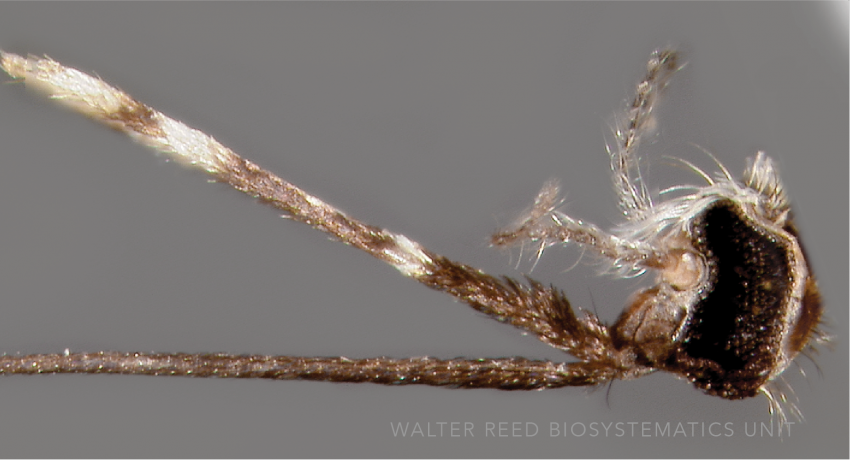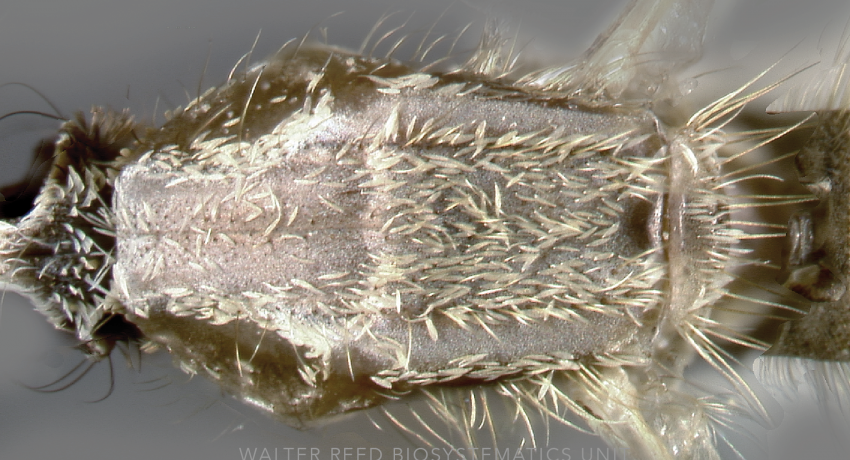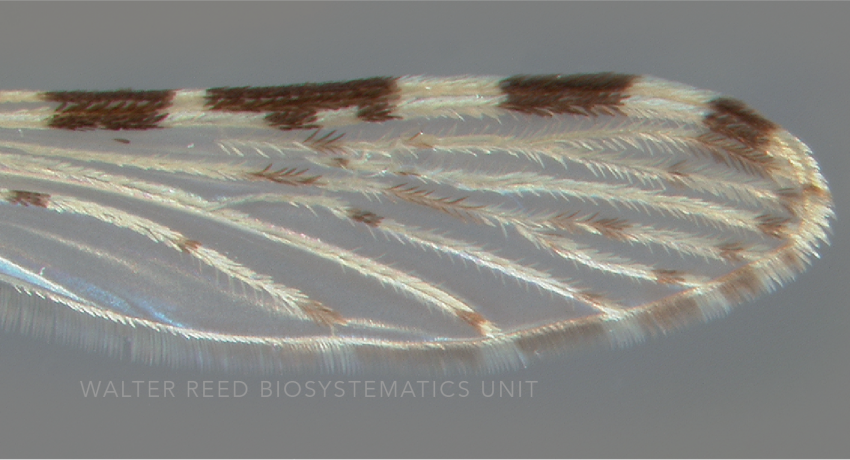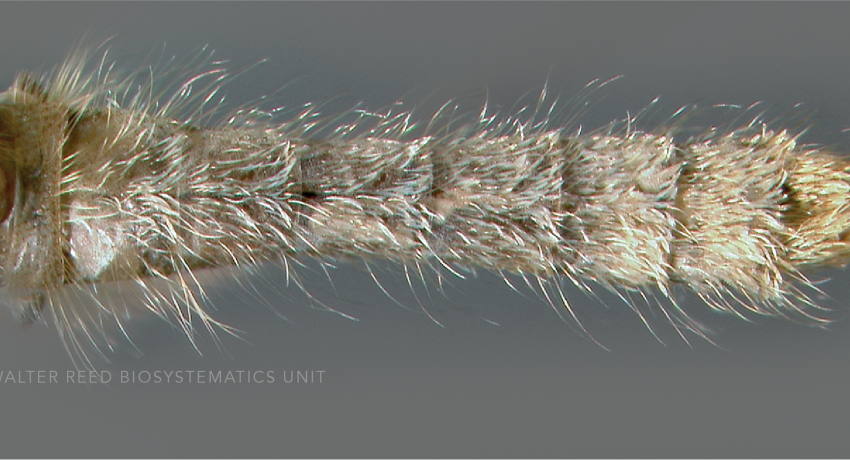INDO-ORIENTAL REGION
[Afrotropical invasive]
Etymology: John William Watson Stephens
Anopheles stephensi is a very attractive species with ornate, heavily spotted upper legs. Three egg forms, differing in size and number of floats, have been recognized—type, intermediate and mysorensis. Genetic analysis using mtDNA COI barcoding clearly indicate two separate taxa: one in India, Pakistan, Djibouti, Ethiopia and derived colony strains, and another distinct species-level group originating in Saudi Arabia. It has four synonyms—metaboles Theobald, intermedia Rothwell, folquei de Mello, and mysorensis Sweet & Rao—but it is unclear how, or if, these correspond to the genetic or chromosomal forms. The species appears to be on the move. In 2014, An. stephensi (type form) was reported from Djibouti, marking its first incursion onto the African continent, and introducing the first urban malaria vector on the African continent. Subsequently, the species has been reported from several localities in Ethiopia, and in the Republic of Sudan. A new incursion of molecularly confirmed type-form was also detected in Mannar Island, Sri Lanka.
Type locality: Ellichpur [Amaroati District, Central Provinces], India
Type depository: Natural History Museum, London, England, United Kingdom (NHMUK)
DIAGNOSTIC CHARACTERS (Click photos to view; mouse over and click large photo to zoom in.)
ADULT (illustrated): Head: Maxillary palpus with pale bands; MPlp5 entirely pale; erect head scales broad, white on vertex and dark brown laterally and posteriorly. Thorax: Scutum with obvious pale scales in addition to setae; scutal fossa with scattered pale scales. Wing: Vein 1A with 3 dark spots; wing with pale spots present on nearly all veins. Abdomen: V–VIII-S usually with pale scales; II–VII-Te without dark scale tufts.
LARVA (not illustrated): Head: Seta 1-A small, unbranched; setae 2,3-C smooth, not aciculate; distance between seta 2-C > distance between setae 2-C and 3-C on one side; setae 5–7-C long and branched. Thorax: Setae 1,2-P inserted on dark, sclerotized tubercles; setae 9,10-P and 9,10-M not all unbranched; seta 9-M plumose, branched from base; setae 10–12-M unbranched; setae 9,10-T branched. Legs: All Fe and Ti spotted with pale scales. Abdominal segments: Tergal plates on segments IV–VII small, not enclosing small median accessory plates.
TAXONOMIC KEYS
Darsie & Pradhan 1990
Glick 1992
Rattanarithikul et al. 2006b
Becker et al. 2010
![]()
WRBU - Anopheles - Neocellia Series - Oriental Region - Larva
![]()
WRBU - Anopheles - Western Palearctic Region - Adult
![]()
WRBU - Genera - Global - Adult
![]()
WRBU - Genera - Global - Larva
![]()
WRBU - Genera - Eastern Palearctic - Adult
![]()
WRBU - Genera - Eastern Palearctic - Larva
![]()
WRBU - Genera - Afrotropical - Adult
![]()
WRBU - Genera - Afrotropical - Larva
Exemplar DNA sequences
An. stephensi COI: KR817728, MG571266, AY729980 (India)
An. stephensi COI: KF933378 (Djibouti)
An. stephensi COI: KJ528887–95 (Saudi Arabia)
An. stephensi whole genome (ASM344897).
BIONOMICS
Immatures
In India, typical immature habitats include stream pools, stream margins, irrigation canals and springs. However, the invasive African immatures have been detected in water cisterns in Djibouti City and Camp Lemmonier, Djibouti, and in various urban/ peri-urban container habitats including abandoned tires in Ethiopia. It is feared that the presence of An. stephensi in high density cities could instigate urban malaria outbreaks in Africa for the first time.
Adults
Distinctive biological traits are associated with the urban (type) and rural (mysorensis) forms of An. stephensi. In urban areas, the type form of An. stephensi is highly anthropophilic, endophilic and immatures are found in high densities in larger artificial containers including wells, cisterns, fountains and water barrels. In rural areas, the mysorensis form is uncommon, strongly zoophilic and exophilic.
DISTRIBUTION NOTES
Afghanistan, Bahrain, Bangladesh, Djibouti, Ethiopia, Ghana, India, Iran, Iraq, Kenya, Kuwait, Myanmar, Nepal, Nigeria, Oman, Pakistan, People's Republic of China, Philippines, Qatar, Saudi Arabia, Somaiia, Sri Lanka, Sudan, Thailand, United Arab Emirates, Vietnam.
WRBU VECTOR HAZARD REPORTS
Anopheles stephensi – incursion into Africa
View other WRBU Vector Hazard Reports
Available GIS Models:
An_stephensi_Dornak_1 Palaearctic
IMPORTANT REFERENCES (full citations below)
Liston 1901: 441 (F*)
Senevet 1930: 325 (P*)
Christophers & Barraud 1931: 179 (E*)
Christophers 1933: 273 (M*, F*, L*)
Rao et al. 1938: 261 (E*)
Ross & Roberts 1943b: 29 (M*, F*, L*; taxonomy, distribution, bionomics)
Pringle 1952: 779 (L*; taxonomy)
Aslamkhan 1971b (distribution; Pakistan)
Aslamkhan et al. 1972: 29 (morphological variation)
Green 1982: 49-61 (chromosomes; stephensi species group). In: Steiner et al. 1982
Townsend 1990: 136 (type information)
Darsie & Pradhan 1990 (F, L; taxonomy, keys, bionomics, distribution; Nepal)
Glick 1992 (F*; key, distribution, taxonomy)
Oo et al. 2004 (distribution; Myanmar)
Rattanarithikul et al. 2006b (F*, L*; bionomics, distribution, keys)
Becker et al. 2010: 347 (F*, L*; key, taxonomy, distribution, bionomics)
Sinka et al. 2011: 89 (bionomics review, distribution, niche model)
Dev & Sharma 2013 (taxonomy, bionomics; stephensi & variants)
Robert et al. 2019 (distribution, western Palaearctic)
CURRENT SYNONYMS
syn. metaboles Theobald
1902a: 374 (F*). Type locality: Lahore [Punjab, Pakistan] (NHMUK).
syn. intermedia Rothwell
1907: 34 (M, F; Neocellia). Type locality: Deesa [Bombay], India (NHMUK).
syn. folquei de Mello
1918: 363 (F*). Type locality: Pragana, Nagar Avely, Damao [India] (IM).
syn. mysorensis Sweet & Rao
1937: 673 (E; as variety). Type locality: India (LU). References: Rao et al. 1938: 262 (E*); Puri 1949: 495 (to subspecies); Rutledge et al. 1970: 1024 (synonymy).
CITED REFERENCES
Aslamkhan, M. (1971b). The mosquitoes of Pakistan I. A checklist. Mosquito Systematics, 3(4), 147–159.
Aslamkhan, M., Aaqil, M., & Hafeez, M. (1972). Genetical and morphological variations in a natural population of the malaria mosquito, Anopheles stephensi from Karachi, Pakistan. Biologia, 18(1), 29–41.
Becker, N., Petrić, D., Zgomba, M., Boase, C., Madon, M., Dahl, C., & Kaiser, A. (2010). Mosquitoes and their control (Second ed.). Berlin Heidelberg: Springer-Verlag.
Christophers, S.R. (1933). The fauna of British India, including Ceylon and Burma. Diptera. Vol. IV. Family Culicidae. Tribe Anophelini. London: Taylor and Francis.
Christophers, S.R., & Barraud, P.J. (1931). The eggs of Indian Anopheles, with descriptions of the hitherto undescribed eggs of a number of species. Records of the Malaria Survey of India, 2(1), 161–192.
Darsie, R.F., Jr., & Pradhan, S.P. (1990). The mosquitoes of Nepal: Their identification, distribution and biology. Mosquito Systematics, 22(2), 69–130.
De Mello, F. (1918). Anopheles folquei n. sp. (Nouvelle espécie anopheline trouvée dans notre province de Pragana). Anais Scientificos da Faculdade de Medicina do Porto, 4, 363–371.
Dev, V., & Sharma, V.P. (2013). The Dominant Mosquito Vectors of Human Malaria in India. In S. Manguin (Ed.), Anopheles mosquitoes - New insights into malaria vectors (pp. 239–271). Janeza Trdine 9, 51000 Rijeka, Croatia: InTech.
Glick, J.I. (1992). Illustrated key to the female Anopheles of southwestern Asia and Egypt (Diptera: Culicidae). Mosquito Systematics, 24(2), 125–153.
Green, C.A. (1982). Polytene-chromosome relationships of the Anopheles stephensi species group from the Afrotropical and Oriental regions (Culicidae, Anopheles (Cellia), series Neocellia). In Steiner, W.W.M.; Tabachnick, W.J.; Rai, K.S.; Narang, S. [Eds]. Recent developments in the genetics of insect disease vectors. Stipes Publishing Company, Illinois, 1982: i-iv, 1–665. Chapter pagination: 49–61.
Liston, W.G. (1901). A year's experience of the habits of Anopheles in Ellichpur. The description of the species of Anopheles found in Ellichpur during the year. Indian Medical Gazette, 36, 361–366, 441–443.
Oo, T.T., Storch, V., & Becker, N. (2004). Review of the Anopheles mosquitoes of Myanmar. Journal of Vector Ecology, 29(1), 21–40.
Pringle, G. (1952). The identification of the larvae of Anopheles stephensi Liston and Anopheles superpictus Grassi in Iraq. Bulletin of Entomological Research, 42, 779–783.
Puri, I.M. (1949). Anophelines of the Oriental Region. In M. F. Boyd (Ed.), Malariology: a comprehensive survey of all aspects of this group of diseases from a global standpoint, by 65 contributors. Philadelphia: W.B. Saunders Co.
Rao, B.A., Sweet, W.C., & Rao, A.M.S. (1938). Ova measurements of A. stephensi type and A. stephensi var. mysorensis. Journal of the Malaria Institute of India, 1, 261- 266.
Rao, B.A., Sweet, W.C., & Rao, A.M.S. (1938). Ova measurements of A. stephensi type and A. stephensi var. mysorensis. Journal of the Malaria Institute of India, 1, 261- 266.
Rattanarithikul, R., Harrison, B.A., Harbach, R.E., Panthusiri, P., & Coleman, R.E. (2006b). Illustrated keys to the mosquitoes of Thailand. IV. Anopheles. Southeast Asian Journal of Tropical Medicine and Public Health, 128(Supplement 2), 2.
Robert, V., Günay, F., Le Goff, G., Boussès, P., Sulesco, T., Khalin, A., Medlock, J.M., Kampen, H., Petrić, D. & F. Schaffner. (2019). Distribution chart for Euro-Mediterranean mosquitoes (western Palaearctic region). Journal of the European Mosquito Control Association, 37, 1–28.
Ross, E.S., & Roberts, H.R. (1943b). Mosquito atlas. Part II. Eighteen old world anophelines important to malaria. Contributions of the American Entomological Institute.
Rothwell, S. (1907). A new mosquito from India. Entomologist London, 34–36.
Rutledge, L.C., Ward, R.A., & Bickley, W.E. (1970). Experimental hybridization of geographic strains of Anopheles stephensi (Diptera: Culicidae). Annals of the Entomological Society of America, 63, 1024–1030.
Senevet, G. (1930). Contribution à l'étude des nymphes de culicides. Description de celles de certain anophelines et plus spécialement des espèces européennes et meditérranéennes. Archives de l'Institut Pasteur d'Algérie, 8, 297–382.
Sinka, M.E., Bangs, M.J., Manguin, S., Chareonviriyaphap, T., Patil, A.P., Temperley, W.H., ... Hay, S.I. (2011). The dominant Anopheles vectors of human malaria in the Asia-Pacific region: Occurrence data, distribution maps and bionomic précis. Parasites & Vectors, 4(1), 89.
Sweet, W.C., & Rao, B.A. (1937). Races of A. stephensi Liston 1901. Indian Medical Gazette, 665–674.
Theobald, F.V. (1902a). A short description of the Culicidae of India, with descriptions of new species of Anopheles. Proceedings of the Royal Entomological Society (B), 69, 367–394.
Townsend, B.C. (1990). Culicidae. In B.C. Townsend, J.E. Chainey, R.W. Crosskey, A.C. Pont, R.P. Lane, J.P.T. Boorman, & C.A. Crouch (Eds.), A catalogue of the types of bloodsucking flies in the British Museum (Natural History). London: British Museum (Natural History).
CITE THIS PAGE
Walter Reed Biosystematics Unit (Year). Anopheles stephensi species page. Walter Reed Biosystematics Unit Website, http://wrbu.si.edu/vectorspecies/mosquitoes/stephensi, accessed on [date (e.g. 03 February 2020) when you last viewed the site].












































































































































































